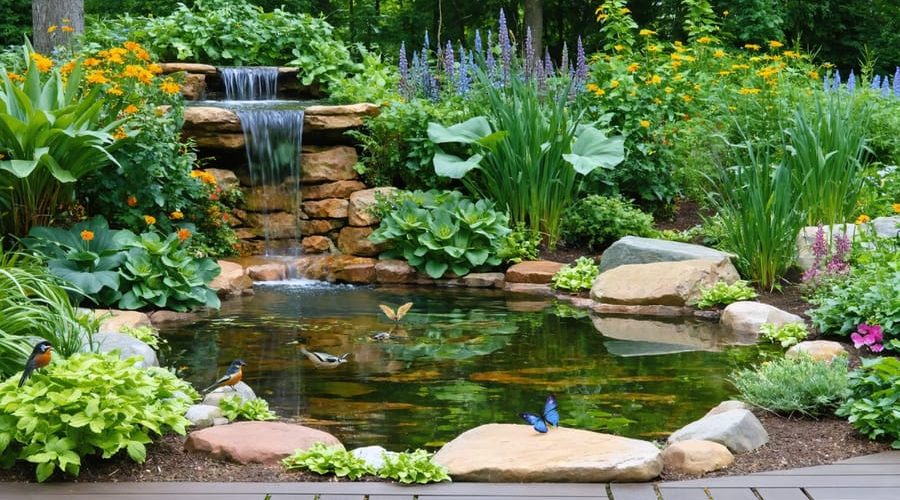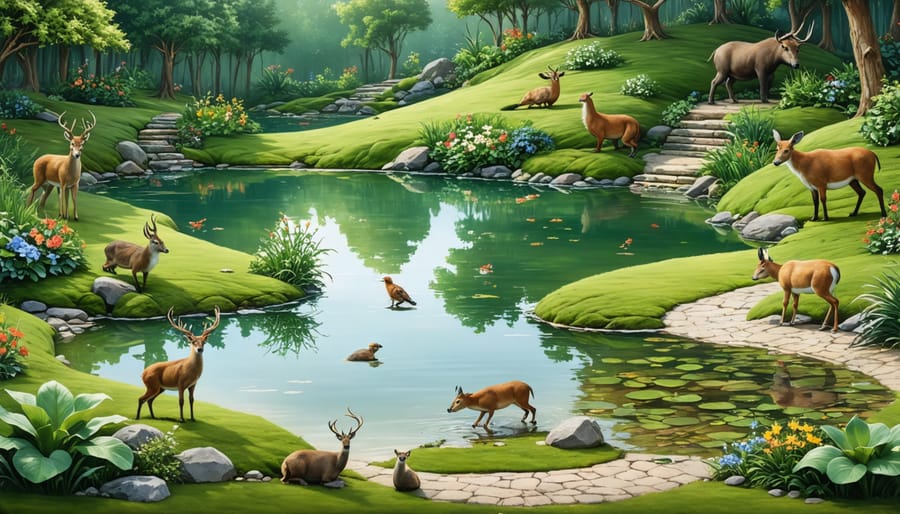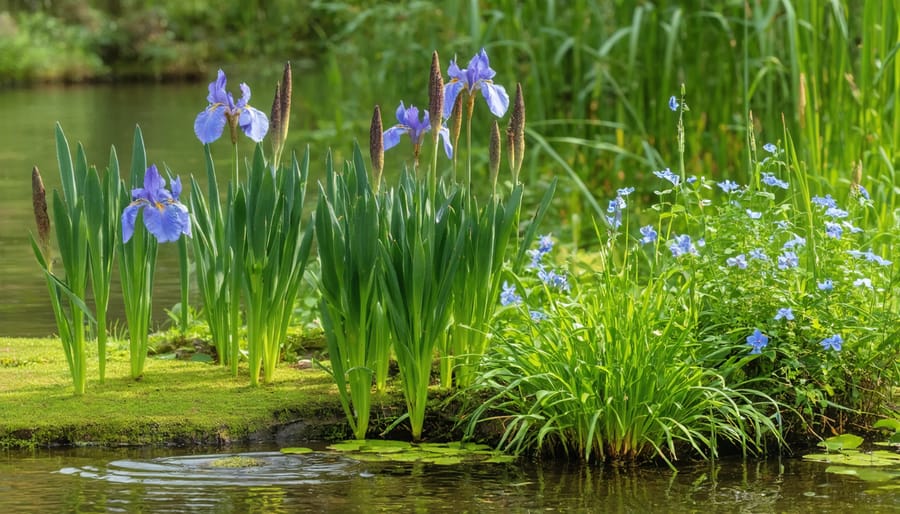
Transform Your Pond into a Thriving Wildlife Watering Hole
Transform your backyard into a thriving ecosystem by creating a dedicated wildlife pond design that serves as a natural watering hole. Position your water feature away from dense tree coverage to prevent excessive leaf debris while maintaining nearby shelter options for visiting wildlife. Shape the pond with varying depths – shallow edges for small animals to drink safely and deeper sections (at least 2 feet) to support aquatic life year-round. Install gently sloping sides using natural materials like river rocks and native water plants to create essential escape routes for visiting creatures.
Establish a diverse habitat around your watering hole by incorporating multiple zones: emergent plants for cover, floating vegetation for shade, and submerged plants for oxygenation. Keep water levels consistent throughout dry spells, using collected rainwater when possible to maintain this vital resource for local wildlife. Monitor water quality regularly, ensuring proper circulation without creating strong currents that might deter smaller visitors.
This natural oasis won’t just attract birds and butterflies – it’ll become a sustainable sanctuary supporting entire food chains, from dragonflies to amphibians, while adding a stunning focal point to your garden.
Essential Features of a Wildlife-Friendly Water Garden
Safe Access Points
Creating safe access points is crucial for wildlife to comfortably approach and use your watering hole. Design gentle slopes with a gradient of about 20-30 degrees, allowing animals of different sizes to easily enter and exit the water. Start with shallow edges of 1-2 inches deep, gradually deepening to create various depth zones.
Include at least two or three entry points around the watering hole to prevent territorial disputes and give smaller creatures alternative escape routes. Place flat rocks or gravel along these slopes to provide secure footing and prevent erosion. These natural-looking materials also help small insects and amphibians navigate the water’s edge.
Remember to incorporate some slightly steeper areas with rocks or logs for turtles and birds to bask, but maintain an easy path back to water. For larger mammals, ensure at least one access point is wide enough (about 2-3 feet) and sturdy enough to support their weight.
In winter, these gradual slopes become especially important as they help prevent animals from getting trapped on slippery surfaces. Regular maintenance of these access points, including removing debris and checking for erosion, ensures safe passage for all wildlife visitors.

Natural Cover and Protection
Natural shelter is essential for wildlife to feel secure when visiting your watering hole. Start by strategically placing rocks of various sizes around the edges – larger boulders create hiding spots for small animals, while flat rocks offer perfect basking areas for turtles and lizards. Consider creating diverse microhabitats by arranging plants at different heights and depths.
Native grasses and rushes along the water’s edge provide cover for frogs and small birds, while taller shrubs a few feet back offer safe perches for larger birds to scope out the area before drinking. Mix in some low-growing groundcovers between rocks to create natural pathways that smaller creatures can use to access the water safely.
Remember to leave some open areas too – animals need clear sight lines to watch for predators while they drink. The key is finding the right balance between cover and accessibility. As your plants mature, they’ll create a more natural-looking setting that makes wildlife feel right at home.
Perfect Plants for Wildlife Attraction
Marginal Plants
The edges of your wildlife watering hole provide the perfect opportunity to create a thriving ecosystem with water-loving plants. For the best results, choose a mix of native species that naturally grow in marshy conditions. Rushes and sedges are excellent choices, as they provide cover for small creatures while helping to stabilize the pond’s edge.
Consider adding marsh marigolds for bright spring color, or iris varieties that thrive in shallow water. These plants not only look beautiful but also help filter the water and provide natural hiding spots for frogs and newts. Japanese sweet flag and cattails are particularly good at creating dense cover, though cattails should be planted in containers to prevent them from spreading too aggressively.
For shallow shelf areas, try water forget-me-nots or water mint, which spread nicely and release lovely fragrances when brushed against. Purple loosestrife and bog bean work wonderfully in deeper marginal areas, offering beautiful blooms that attract butterflies and bees.
Remember to plant in groups rather than single specimens for the best visual impact and wildlife benefit. Place taller species toward the back and shorter ones in front, creating a natural-looking transition from water to land. Most marginal plants prefer to have their roots submerged in 2-6 inches of water, so adjust your shelving accordingly when planning your pond design.

Surrounding Vegetation
Creating a lush border around your wildlife watering hole not only enhances its natural beauty but also provides essential shelter and food sources for visiting creatures. Native plants are your best choice, as they’re already adapted to your local climate and will attract familiar wildlife species.
Consider incorporating different heights of vegetation to create a layered effect. Tall grasses like sedges and rushes offer perfect hiding spots for smaller animals, while flowering plants such as cardinal flowers and blue iris add splashes of color and attract pollinators. Hardy perennials like marsh marigolds and water primrose thrive in moist soil conditions around pond edges.
For additional shelter, include some low-growing shrubs like buttonbush or swamp azalea a few feet back from the water’s edge. These create safe corridors for wildlife to approach the water while staying protected from predators. Leave some open areas too – many creatures need clear paths to access the water.
Remember to avoid invasive species that might overwhelm your pond ecosystem. Instead, opt for a mix of plants that bloom at different times throughout the season, ensuring your watering hole remains attractive to wildlife year-round. Some plants will naturally spread over time, creating a more established and maintenance-free environment.
Consider adding a few partially submerged logs or rocks near the vegetation, creating basking spots for turtles and frogs while adding natural character to your water feature.
Maintaining Your Wildlife Watering Hole
Water Quality Management
Keeping your wildlife watering hole clean and healthy doesn’t require harsh chemicals or complex filtration systems. Nature provides excellent solutions to maintain natural pond balance while creating a safe environment for visiting creatures.
Floating plants like water lilies and duckweed naturally filter the water by absorbing excess nutrients and providing shade that prevents algae growth. Adding submerged plants such as hornwort or anacharis helps oxygenate the water while removing harmful compounds.
Creating a shallow gravel area around the edges serves two purposes: it acts as a natural filter and provides safe access for smaller wildlife. Beneficial bacteria that naturally colonize the gravel help break down organic matter and keep the water clear.
Consider adding a small solar-powered fountain or bubbler to keep water moving. This gentle circulation prevents stagnation and mosquito breeding while maintaining healthy oxygen levels. Just ensure the movement isn’t too strong, as gentle ripples are most attractive to wildlife.
Regular skimming of fallen leaves and natural debris helps prevent excess organic matter from decomposing in the water. Leave some plant material, though, as it provides hiding spots for smaller creatures and helps sustain the natural ecosystem.
During hot summers, top up water levels with collected rainwater rather than treated tap water. This maintains the natural mineral balance and keeps your watering hole inviting for local wildlife year-round.
Seasonal Care Tips
Maintaining your wildlife watering hole requires attention to seasonal changes to keep it welcoming for local fauna year-round. In spring, remove dead plant material and check for winter damage. This is also the perfect time to clean out debris and add new native plants while being mindful not to disturb any early breeding amphibians.
Summer brings increased evaporation, so monitor water levels daily and top up as needed, preferably with collected rainwater. Keep algae in check by adding floating plants that provide shade and help maintain water quality. Remember to maintain a gentle slope at the edges to allow easy access for smaller creatures.
As autumn approaches, install a leaf net to prevent excess organic matter from decomposing in the water. Begin reducing plant maintenance but ensure access points remain clear of fallen leaves and debris. Consider adding a small floating device in one section to prevent complete freezing during winter.
Winter requires special attention to ensure wildlife can access water when other sources are frozen. Keep a small area ice-free using a floating deicer, but avoid breaking ice directly as this can harm hibernating creatures. Maintain at least one shallow access point and clear snow from the edges to help animals spot the water source.
Year-round, ensure predator-safe zones remain intact and maintain water depth variations to accommodate different species. Regular monitoring of water quality and wildlife activity will help you adjust care routines as needed.

Creating a wildlife watering hole in your garden is more than just a beautiful addition to your outdoor space – it’s a vital contribution to local wildlife conservation. By following the guidelines we’ve discussed, you can create a thriving ecosystem that supports various creatures, from birds and butterflies to beneficial amphibians.
Remember to focus on the key elements: proper depth variations, gentle slopes for easy access, natural filtration through plants, and regular maintenance. The rewards of your efforts will be immediately visible as local wildlife begins to discover and utilize your water feature.
Start small if you’re new to water gardening, and don’t be afraid to adapt your design as you learn what works best in your specific environment. Every season will bring new visitors and learning opportunities, making your wildlife watering hole an ever-evolving project.
Whether you’re an experienced gardener or just starting, creating a wildlife-friendly water feature is a rewarding way to connect with nature and make a positive impact on your local ecosystem. Why not begin planning your own wildlife watering hole today? Your garden’s future residents are waiting!
